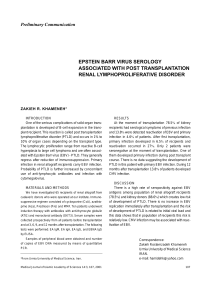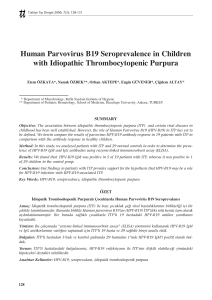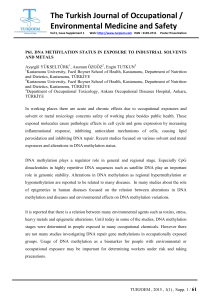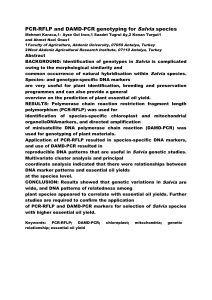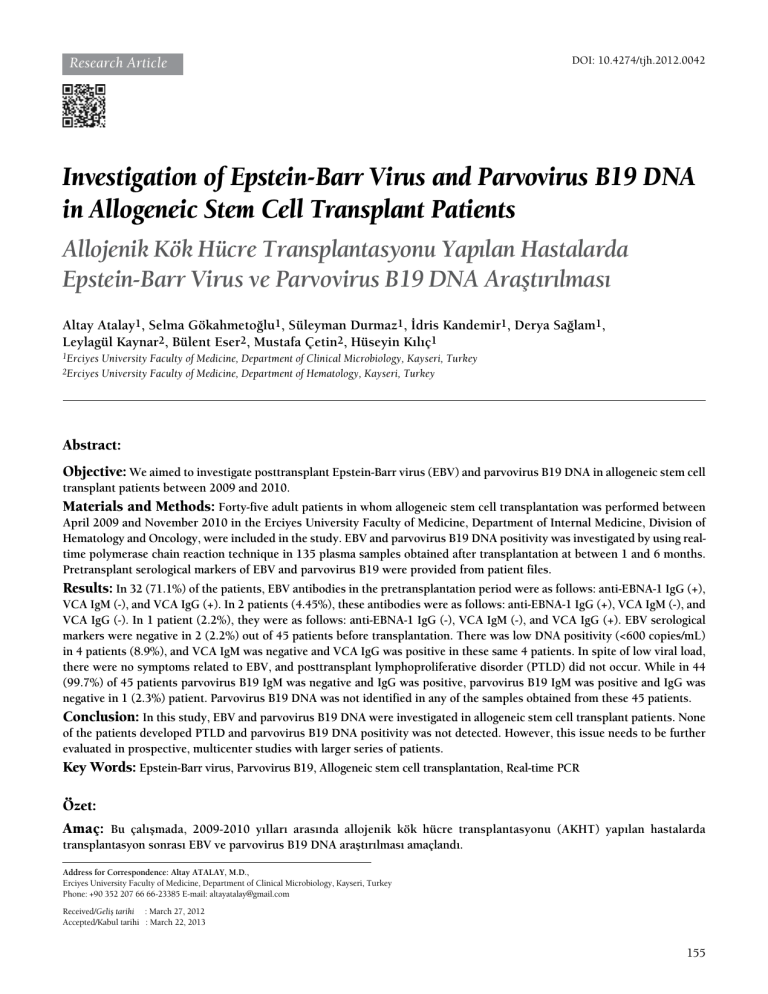
Research Article
DOI: 10.4274/tjh.2012.0042
Investigation of Epstein-Barr Virus and Parvovirus B19 DNA
in Allogeneic Stem Cell Transplant Patients
Allojenik Kök Hücre Transplantasyonu Yapılan Hastalarda
Epstein-Barr Virus ve Parvovirus B19 DNA Araştırılması
Altay Atalay1, Selma Gökahmetoğlu1, Süleyman Durmaz1, İdris Kandemir1, Derya Sağlam1,
Leylagül Kaynar2, Bülent Eser2, Mustafa Çetin2, Hüseyin Kılıç1
1Erciyes
2Erciyes
University Faculty of Medicine, Department of Clinical Microbiology, Kayseri, Turkey
University Faculty of Medicine, Department of Hematology, Kayseri, Turkey
Abstract:
Objective: We aimed to investigate posttransplant Epstein-Barr virus (EBV) and parvovirus B19 DNA in allogeneic stem cell
transplant patients between 2009 and 2010.
Materials and Methods: Forty-five adult patients in whom allogeneic stem cell transplantation was performed between
April 2009 and November 2010 in the Erciyes University Faculty of Medicine, Department of Internal Medicine, Division of
Hematology and Oncology, were included in the study. EBV and parvovirus B19 DNA positivity was investigated by using realtime polymerase chain reaction technique in 135 plasma samples obtained after transplantation at between 1 and 6 months.
Pretransplant serological markers of EBV and parvovirus B19 were provided from patient files.
Results: In 32 (71.1%) of the patients, EBV antibodies in the pretransplantation period were as follows: anti-EBNA-1 IgG (+),
VCA IgM (-), and VCA IgG (+). In 2 patients (4.45%), these antibodies were as follows: anti-EBNA-1 IgG (+), VCA IgM (-), and
VCA IgG (-). In 1 patient (2.2%), they were as follows: anti-EBNA-1 IgG (-), VCA IgM (-), and VCA IgG (+). EBV serological
markers were negative in 2 (2.2%) out of 45 patients before transplantation. There was low DNA positivity (<600 copies/mL)
in 4 patients (8.9%), and VCA IgM was negative and VCA IgG was positive in these same 4 patients. In spite of low viral load,
there were no symptoms related to EBV, and posttransplant lymphoproliferative disorder (PTLD) did not occur. While in 44
(99.7%) of 45 patients parvovirus B19 IgM was negative and IgG was positive, parvovirus B19 IgM was positive and IgG was
negative in 1 (2.3%) patient. Parvovirus B19 DNA was not identified in any of the samples obtained from these 45 patients.
Conclusion: In this study, EBV and parvovirus B19 DNA were investigated in allogeneic stem cell transplant patients. None
of the patients developed PTLD and parvovirus B19 DNA positivity was not detected. However, this issue needs to be further
evaluated in prospective, multicenter studies with larger series of patients.
Key Words: Epstein-Barr virus, Parvovirus B19, Allogeneic stem cell transplantation, Real-time PCR
Özet:
Amaç: Bu çalışmada, 2009-2010 yılları arasında allojenik kök hücre transplantasyonu (AKHT) yapılan hastalarda
transplantasyon sonrası EBV ve parvovirus B19 DNA araştırılması amaçlandı.
Address for Correspondence: Altay ATALAY, M.D.,
Erciyes University Faculty of Medicine, Department of Clinical Microbiology, Kayseri, Turkey
Phone: +90 352 207 66 66-23385 E-mail: altayatalay@gmail.com
Received/Geliş tarihi : March 27, 2012
Accepted/Kabul tarihi : March 22, 2013
155
Atalay A, et al: EBV and PV B19 After the ASCT
Turk J Hematol 2014;31:155-160
Gereç ve Yöntemler: Bu çalışmaya Erciyes Üniversitesi Tıp Fakültesi İç Hastalıkları Anabilim Dalı HematolojiOnkoloji Bilim Dalı’nda Nisan 2009-Kasım 2010 tarihleri arasında AKHT yapılmış 45 erişkin hasta dahil edildi. Hastaların
transplantasyon sonrası 1-6. aylar arasında alınan toplam 135 plazma örneğinde EBV ve parvovirus B19 DNA varlığı gerçek
zamanlı PCR yöntemi ile araştırıldı. Hastalara ait transplantasyon öncesi EBV ve parvovirus B19 serolojik göstergeleri hasta
dosyalarından temin edildi.
Bulgular: AKHT öncesi serolojik göstergelerde, 45 hastanın 32’sinde (%71,1) EBNA-1 IgG (+), VCA IgM (-) ve VCA IgG (+)
idi. İki hastada (%4,45) EBNA-1 IgG (+), VCA IgM (-) ve VCA IgG (-), bir hastada (%2,2) EBNA-1 IgG (-), VCA IgM (-) ve VCA
IgG (+) ve 2 (%4,45) hastada tüm serolojik göstergeler negatifti. Transplantasyon sonrası düşük EBV DNA pozitifliği (<600
kopya/mL) 4 (%8,9) hastada saptandı, bu hastaların hepsinde VCA IgM negatif, VCA IgG pozitif bulundu. Düşük viral yüke
rağmen bu hastalarda EBV ilişkili semptom görülmemiş ve PTLD gelişmemiştir. Kırk beş hastanın 44’ünde (%97,7) parvovirus
B19 IgM negatif, IgG pozitif iken sadece bir hastada (%2,3) parvovirus B19 IgM pozitif, IgG negatifti. Kırk beş hastadan elde
edilen örneklerin hiçbirinde parvovirus B19 DNA saptanmadı.
Sonuç: Bu çalışmada AKHT hastalarında EBV ve parvovirus B19 DNA araştırıldı. Hastaların hiçbirinde PTLD gelişmezken
parvovirus B19 DNA pozitifliği de saptanmadı. Ancak bu konunun aydınlatılmasında daha geniş hasta serileri ile yapılan,
prospektif, çok merkezli ileri çalışmalara ihtiyaç vardır.
Anahtar Sözcükler: Epstein-Barr virüs, Parvovirus B19, Allojenik kök hücre transplantasyonu, Gerçek zamanlı PCR
Introduction
Allogeneic stem cell transplantation (ASCT) has been
applied as a treatment option in an ever-increasing manner
in various malignancies and hematological disorders for
40 years [1]. Posttreatment infections and graft-versushost disease are the most common problems in ASCT
[2]. Cytomegalovirus (CMV) is still the most important
virus that infects hematopoietic stem cell and solid organ
transplant recipients. However, the list of viruses that infect
these patients and cause severe morbidity and mortality gets
longer each day [3].
The Epstein-Barr virus (EBV) is a member of the family
Herpesviridae. EBV infects almost all of the adult population
in the world and stays persistent throughout life, as do all
the other herpes viruses. Bone marrow transplant recipients
carry a 4- to 7- fold increased risk of cancer compared to the
normal population. Severe immune deficiency is observed
within the first year after transplantation. Posttransplant
lymphoproliferative disorder (PTLD) mostly appears in
this period, and especially in the first 5 months. The mean
PTLD incidence is 1% in allogeneic SCT recipients [4,5].
Human parvovirus (PV) B19 is the smallest DNA virus
known so far, a nonenveloped microorganism of 18-26
nm in size [6]. Chronic PV B19 infections are described
in many patients following stem cell transplantation. The
infections encountered during chemotherapy in this patient
group may mimic leukopenic relapses or therapy-induced
cytopenias, and thus may cause misdiagnoses, unnecessary
blood transfusions, and premature abortion of treatment
[7,8]. Therefore, rapid diagnosis and treatment of PV B19
infections is very important in this patient group.
The aim of this study was to investigate the occurrence of
EBV-DNAemia after ASCT and its duration and magnitude,
and to correlate these results with the appearance of
156
EBV-driven PTLD. At the same time, another aim was to
investigate the occurrence, duration, and magnitude of PV
B19-DNAemia after ASCT.
Materials and Methods
Forty-five adult patients who underwent ASCT at the
Erciyes University Medical Faculty, Department of Internal
Medicine, Division of Hematology and Oncology, between
April 2009 and November 2010 were included in the study.
The presence of EBV and PV B19 DNA were investigated
in a total of 135 plasma samples via real-time polymerase
chain reaction (PCR) in the posttransplantation period (3
samples from each patient for EBV between the first and
sixth months; 3 samples for each patient for PV B19 in the
first, second, and third months). Two milliliters of blood
samples with ethylenediaminetetraacetic acid was taken
from all patients for the investigations of EBV and PV B19
DNAs. Plasma was separated following centrifugation and
kept at -70 °C until analyses. DNA extraction from blood
plasma was performed by the recommendations of the
manufacturer using the EZ1 advanced virus kit (QIAGEN,
Germany). DNAs were analyzed via real-time PCR using the
EBV RG PCR kit (QIAGEN) for EBV and PV B19 RG PCR kit
(QIAGEN) for PV B19. Extracted DNA (10 µL) was added to
the plaques containing 15 µL of reaction mixture. An internal
control of approximately 0.25 µL was added to the reaction
mixture. PCR was conducted for 10 min at 95 °C, and then
45 cycles were repeated as follows: 1 cycle was composed of
15 s at 95 °C, 30 s at 55 °C, and 20 s at 72 °C. Amplification
was performed in a Rotor-Gene 6000 instrument (Corbett
Research, Australia). The quantitation range of the realtime PCR test for EBV was 600-600.000 copies/mL, and
the analytic sensitivity was 157 copies/mL. For PV B19, the
quantitation range was 1500-15.000.000 copies/mL and the
analytic sensitivity was 30 copies/mL. The serological EBV
Turk J Hematol 2014;31:155-160
Atalay A, et al: EBV and PV B19 After the ASCT
and PV B19 indicators of patients were obtained from the
patient files. The ethics committee approved this study.
Statistical
Statistical analysis was performed using SPSS 13.0.
Categorical variables are presented as numbers and
percentages, and continuous variables are presented as mean
± SD or median.
Results
The demographical characteristics of patients included
in the study are shown in Table 1. HLA-matching status for
ASCT was full-match in 35 patients and all of the allogeneic
transplant donors were related. According to the pre-ASCT
serological indicators of the patient files, 32 of 45 patients
(71.1%) were EBNA-1 IgG (+), VCA IgM (-), and VCA IgG
(+). Two patients (4.45%) were EBNA-1 IgG (+), VCA IgM
(-), and VCA IgG (-); 1 patient (2.2%) was EBNA-1 IgG
(-), VCA IgM (-), and VCA IgG (+); and 2 patients (4.45%)
were serologically negative for all indicators. EBNA-1 IgG
results could not be obtained for 8 (17.8%) patients. Six
of these 8 patients (75%) were VCA IgM (-) and VCA IgG
(+), whereas 2 (25%) were VCA IgM (-) and VCA IgG
(-). EBV-specific antibody EA was negative in 34 patients
(75.5%) and positive in 1 patient (2.2%). The EA-positive
patient was VCA IgM (-), VCA IgG (+), and EBNA-1
IgG (+). EA results could not be obtained for 10 patients
(22.3%). EBV DNA was positive (<600 copies/mL) in 4
patients (8.9%), and they were all VCA IgM (-) and VCA
IgG (+). EBV DNA positivity of these patients belonged
to the posttransplantation third month in 2 patients, fifth
month in 1 patient, and sixth month in 1 patient (Table 2).
No EBV-related symptom or PTLD was observed in these
patients despite the low viral load. We wanted to follow the
results of all 4 patients that had low EBV viral load, but 1 of
them died and 1 went to another hospital for treatment. We
were able to check the results of the other 2 patients, and
EBV DNA was found to be negative.
In 44 (97.7%) of 45 patients, PV B19 IgM was negative
and IgG was positive, whereas in only 1 patient (2.3%), PV
B19 IgM was positive and IgG was negative. No PV B19
DNA was observed in the samples obtained from these
45 patients. EBV and PV B19 serology of the donors and
patients included in the study are shown in Table 3.
Discussion
Determining a patient’s risk factors concerning
posttransplantation viral infection development may be
possible by detecting the virological situations of both the
Table 1. Demographic characteristics of patients.
Patient characteristics
n±SD
Age (years)
33.3±11.3
Sex
n (%)
Female
20 (44.4)
Male
25 (55.6)
Pre-ASCT diagnosis
n (%)
Acute myeloid leukemia
21 (46.8)
Aplastic anemia
12 (26.7)
Myelofibrosis
3 (6.7)
Chronic myeloid leukemia
2 (4.4)
Paroxysmal nocturnal hemoglobinuria
2 (4.4)
Non-Hodgkin lymphoma
1 (2.2)
Hodgkin lymphoma
1 (2.2)
Multiple myeloma
1 (2.2)
Table 2. Demographic characteristics, serological indicators, and positivity times of patients with positive EBV DNA.
Patient’s
age/sex/diagnosis
EBV-specific antibodies
Posttransplantation EBV DNA
positivity time (months)
EA
EBNA
VCA
IgM
VCA
IgG
32/F/ALL
-
+
-
+
5
23/F/ALL
-
+
-
+
6
23/F/AML
-
+
-
+
3
53/F/AML
-
+
-
+
3
F: Female, EA: early antigen, EBNA: Epstein-Barr nuclear antigen, VCA: viral capsid antigen, ALL: acute lymphocytic leukemia, AML: acute myeloid leukemia
157
Turk J Hematol 2014;31:155-160
Atalay A, et al: EBV and PV B19 After the ASCT
Table 3. EBV and PV B19 serology of the donors and patients.
EBV-specific antibodies
Parvovirus B19-specific
antibodies
D
EA
P
D
P
EA EBNA EBNA
D
VCA
IgM
P
VCA
IgM
D
VCA
IgG
P
VCA
IgG
D
IgM
P
IgM
D
IgG
P
IgG
1
2
3
4
5
6
7
8
9
10
11
12
13
14
15
16
17
18
19
20
21
22
23
24
25
26
27
28
29
30
31
32
33
34
35
36
37
38
39
40
41
42
43
44
NA
NA
NA
NA
NA
NA
NA
NA
NA
NA
NA
NA
NA
NA
NA
-
NA
NA
NA
NA
NA
+
NA
NA
NA
NA
-
NA
NA
+
+
+
+
+
+
+
NA
+
+
NA
+
+
NA
+
NA
NA
+
+
+
+
+
+
+
+
+
+
NA
NA
NA
+
+
+
NA
+
NA
NA
NA
NA
+
NA
NA
+
+
+
+
+
NA
+
+
+
+
+
+
+
+
+
+
+
+
+
+
+
+
NA
+
+
+
+
NA
+
+
+
+
NA
+
+
NA
NA
+
+
NA
NA
NA
NA
NA
NA
NA
-
-
NA
+
+
+
+
+
+
+
+
+
NA
+
+
NA
+
+
NA
+
NA
+
+
+
+
+
+
+
+
+
+
+
+
+
NA
+
+
+
+
+
+
+
NA
+
+
+
+
+
+
+
+
+
+
+
+
+
+
+
+
+
+
+
+
+
+
+
+
+
+
+
+
+
+
+
+
+
+
+
+
+
+
+
+
NA
NA
NA
NA
NA
NA
NA
NA
NA
-
+
-
+
+
+
+
+
+
+
+
+
+
NA
+
+
NA
+
+
+
+
+
+
+
+
+
+
+
+
+
+
+
+
+
NA
NA
NA
+
+
+
NA
+
NA
NA
+
NA
+
+
+
+
+
+
+
+
+
+
+
+
+
+
+
+
+
+
+
+
+
+
+
+
+
+
+
+
+
+
+
+
+
+
+ v
+
+
+
+
+
+
+
+
+
45
NA
NA
NA
+
-
-
+
+
NA
-
NA
+
Patient no.
D: Donor, P: Patient, EA: Early antigen, EBNA: Epstein-Barr nuclear antigen, VCA: Viral capsid antigen, NA: Not available.
158
Turk J Hematol 2014;31:155-160
Atalay A, et al: EBV and PV B19 After the ASCT
donor and the recipient just before transplantation. However,
this detection alone is not enough; the recipients should be
followed regularly after the transplantation and tested in
respect to possible viral infections [9]. The viral infections
of the posttransplantation period may vary according to the
type of the transplant. In patients with stem cell or bone
marrow transplantation, polyoma, herpes simplex (HSV),
and respiratory and enteric viral infections are common in
the first month following the transplantation. In solid organ
transplantation recipients, HSV infections are common in
the first month following transplantation. In both groups,
CMV, EBV, and varicella zoster virus infections may be seen
after the second month. Periodic follow-up for viruses other
than CMV is suggested in the posttransplantation period.
However, no standardization has been provided yet [10].
The serological status of EBV in transplant recipients
should be certain before the transplantation since
seronegativity is a risk factor. Serology is limited since the
severe immunosuppression of transplant recipients after
the transplantation procedure inhibits the production of
sufficient antibodies. Follow-up of the viral load by nucleic
acid amplification tests is the preferred method [11].
Sometimes EBV may infect T/NK cells and cause persistent
EBV infection. As a result, a high viral load and EBV-related
T/NK cell lymphoproliferative disease follow. Therefore, the
quantitation of EBV viral load is important, and the most
common method used for this purpose is real-time PCR
[12]. PCR-based tests are useful not only in prediction and
diagnosis of PTLD, but also in monitoring the response
to the treatment [13]. In ASCT patients with PTLD, EBV
DNA load is generally higher than that of ASCT patients
without PTLD. However, no consensus has been reached
concerning which EBV DNA load threshold values cause
high risk for EBV-related disease or PTLD development [14].
On the other hand, patients with immunodeficiency may
not manifest EBV-related symptoms despite the detectable
EBV DNA in their serum or plasma samples [15]. In our
study, EBV-related symptoms or PTLD was not present in
any of the patients who were detected to be positive for
EBV DNA via real-time PCR. Agbalika et al. [16] mentioned
that EBV EA-IgG presence in pre-ASCT patients increased
the incidence of early PTLD development in the first year
following transplantation. In this study, EBV DNA positivity
was detected in 4 posttransplantation patients, and the
positivity times were as follows: third month in 2 patients,
fifth month in 1 patient, and sixth month in 1 patient. EAIgG was negative in 34 (75.5%) patients and positive in 1
(2.2%) patient. EA-IgG results could not be obtained in 10
cases (22.3%). No EA-IgG positivity was detected before
transplantation in any of the 4 patients with EBV DNA
positivity.
PV B19 infections may be met in immunosuppression
situations such as congenital or acquired immune deficiency
syndrome, organ or bone marrow transplantation,
lymphoproliferative
disorders,
malignancies,
and
chemotherapy [17]. In immunosuppressed patients, the
clinical findings of PV B19 infection are severe, and viral
eradication is late or inadequate. That may cause an aplastic
crisis in patients with chronic hemolytic anemia [18].
Plentz et al. [19] detected PV B19 DNA in 21 (1%) of
2123 tested blood samples that were going to be transplanted
to patients with hematological cancer [18]. In the
posttransplantation period of patients with ASCT, primary
or recurrent PV B19 incidence is found to be 1%-2% when
sensitive diagnostic methods are used [8,19]. As PV B19
cannot proliferate in continuous cell cultures and serological
diagnosis is not reliable in immunosuppressed patients, viral
particle- or viral DNA-detecting methods such as PCR and
nucleic acid hybridization are needed for diagnosis [20,21].
Manaresi et al. [22] demonstrated that PV B19 DNA could
be detected by PCR even if the samples were IgM- and IgGnegative. They also noted the importance of real-time PCR
in laboratory diagnosis of PV B19 infections by pointing out
that real-time PCR is 5-fold faster than PCR-ELISA and has a
high specificity/sensitivity and low contamination risk, and
quantitation is possible. Harder et al. [23] emphasized the
usefulness of quantitation of viremia by real-time PCR in
immunosuppressed, reinfected children for the planning of
their treatment. In our study, no PV B19 DNA was detected
in any of the posttransplantation patients, 44 of whom were
detected to be PV IgM (-) and IgG (+), and 1 of whom was
IgM (+) and IgG (-) before ASCT.
As a conclusion, in this study investigating EBV and
PV B19 DNAs in ASCT patients, no PTLD development
or PV B19 DNA positivity was observed. However, further
prospective, multicenter studies with wider patient series
should be conducted in order to better clarify the subject.
Conflict of Interest Statement
The authors of this paper have no conflicts of interest,
including specific financial interests, relationships, and/
or affiliations relevant to the subject matter or materials
included.
References
1. Rieger CT, Rieger H, Kolb HJ, Peterson L, Huppmann S, Fiegl
M, Ostermann H. Infectious complications after allogeneic
stem cell transplantation: incidence in matched-related and
matched-unrelated transplant settings. Transpl Infect Dis
2009;11:220-226.
2. Gratwohl A, Brand R, Frassoni F, Rocha V, Niederwieser
D, Reusser P, Einsele H, Cordonnier C ;Acute and
Chronic Leukemia Working Parties; Infectious Diseases
Working Party of the European Group for Blood and
Marrow Transplantation. Cause of death after allogeneic
haematopoietic stem cell transplantation (HSCT) in
early leukamias: an EBMT analysis of lethal infectious
complications and changes over calender time. Bone
Marrow Transplant 2005;36:757-769.
3. Fischer SA. Emerging viruses in transplantation: there is
159
Turk J Hematol 2014;31:155-160
more to infection after transplant than CMV and EBV.
Transplantation 2008;86:1327-1339.
4. Epstein MA, Crawford DH. Gammaherpesviruses: EpsteinBarr virus. In: Mahy BWJ, Volker TM (eds). Topley and
Wilson’s Microbiology and Microbial Infections, Virology
Volume 1. 10th ed. London, UK, Hodder Education, 2005.
5. Wagner HJ, Rooney CM, Heslop HE. Diagnosis and
treatment of posttransplantation lymphoproliferative
disease after hematopoietic stem cell transplantation. Biol
Blood Marrow Transplant 2002;8:1-8.
6. Zerbini M, Musiani M. Human parvoviruses. In: Murray
PR, Baron EJ, Jorgensen JH, Pfaller MA, Yolken RH (eds).
Manual of Clinical Microbiology. 8th ed. Washington, DC,
USA, ASM Press, 2003.
7. Lackner H, Sovinz P, Benesch M, Aberle SW, Schwinger
W, Schmidt S, Strenger V, Pliemitscher S, Urban C. The
spectrum of parvovirus B19 infection in a pediatric hematooncologic ward. Pediatr Infect Dis J 2011;30:440-442.
8. Broliden K. Parvovirus B19 infection in pediatric solidorgan and bone marrow transplantation. Pediatr Transplant
2001;5:320-330.
9. Ljungman P. Risk assessment in haematopoietic stem cell
transplantation: viral status. Best Pract Res Clin Haematol
2007;20:209-217.
10.Çolak D. Transplant alıcılarında virolojik ve immünolojik
monitörizasyon. Ustaçelebi Ş, Abacıoğlu H, Badur S (eds).
III. Ulusal Viroloji Kongresi, Konferanslar ve Bildiriler
Kitabı. Ankara, Turkey, Öncü Basımevi, 2007 (in Turkish).
11.Rowe DT, Webber S, Schauer M, Reyes J, Green M. EpsteinBarr virus load monitoring: its role in the prevention and
management of post-transplant lymphoproliferative disease.
Transpl Infect Dis 2001;3:79-87.
12.Yamashita N, Kimura H, Morishima T. Virological aspects
of Epstein-Barr virus infections. Acta Med Okayama
2005;59:239-246.
13.
Wagner HJ, Rooney CM, Heslop HE. Diagnosis and
treatment of posttransplantation lymphoproliferative
disease after hematopoietic stem cell transplantation. Biol
Blood Marrow Transplant 2002;8:1-8.
14.Styczynski J, Einsele H, Gil L, Ljungman P. Outcome of
160
Atalay A, et al: EBV and PV B19 After the ASCT
treatment of Epstein-Barr virus-related post-transplant
lymphoproliferative disorder in hematopoietic stem cell
recipients: a comprehensive review of reported cases.
Transpl Infect Dis 2009;11;383-392.
15.Linde A. Epstein-Barr virus. In: Murray PR, Baron EJ,
Jorgensen JH, Pfaller MA, Yolken RH (eds). Manual of
Clinical Microbiology. 8th ed. Washington, DC, USA, ASM
Press, 2003.
16.Agbalika F, Larghero J, Esperou H, Marais D, Robin M, Fois
E, de Latour RP, Gluckman E, Rocha V, Benbunan M, Socie
G, Marolleau JP. Epstein-Barr virus early-antigen antibodies
before allogeneic haematopoietic stem cell transplantation
as a marker of risk of post-transplant lymphoproliferative
disorders. Br J Haematol 2007;136:305-308.
17.Kuo SH, Lin LI, Chang CJ, Liu YR, Lin KS, Cheng AL.
Increased risk of parvovirus B19 infection in young adult
cancer patients receiving multiple courses of chemotherapy.
J Clin Microbiol 2002;40:3909-3912.
18.Plentz A, Hahn J, Knoll A, Holler E, Jilg W, Modrow S.
Exposure of hematologic patients to parvovirus B19 as a
contaminant of blood cell preparations and blood products.
Transfusion 2005;45:1811-1815.
19.Hayes-Lattin B, Seipel TJ, Gatter K, Heinrich MC, Maziarz
RT. Pure red cell aplasia associated with parvovirus B19
infection occurring late after allogeneic bone marrow
transplantation. Am J Hematol 2004;75:142-145.
20.
Yetgin S, Elmas SA. Parvovirus-B19 and hematologic
disorders. Turk J Hematol 2010;27:224-233.
21.Cavallo R, Merlino C, Re D, Bolero C, Bergalla M, Lembo
D, Musso T, Leonardi G, Segoloni GP, Ponzi AN. B19
virus infection in renal transplant recipients. J Clin Virol
2003;26:361-368.
22.Manaresi E, Gallinella G, Zuffi E, Bonvicini F, Zerbini
M, Musiani M. Diagnosis and quantitative evaluation of
parvovirus B19 infections by real-time PCR in the clinical
laboratory. J Med Virol 2002;67:275-281.
23.Harder TC, Hufnagel M, Zahn K, Beutel K, Schmitt HJ,
Ullmann U, Rautenberg P. New LightCycler PCR for rapid
and sensitive quantification of parvovirus B19 DNA guides
therapeutic decision-making in relapsing infections. J Clin
Microbiol 2001;39:4413-4419.

